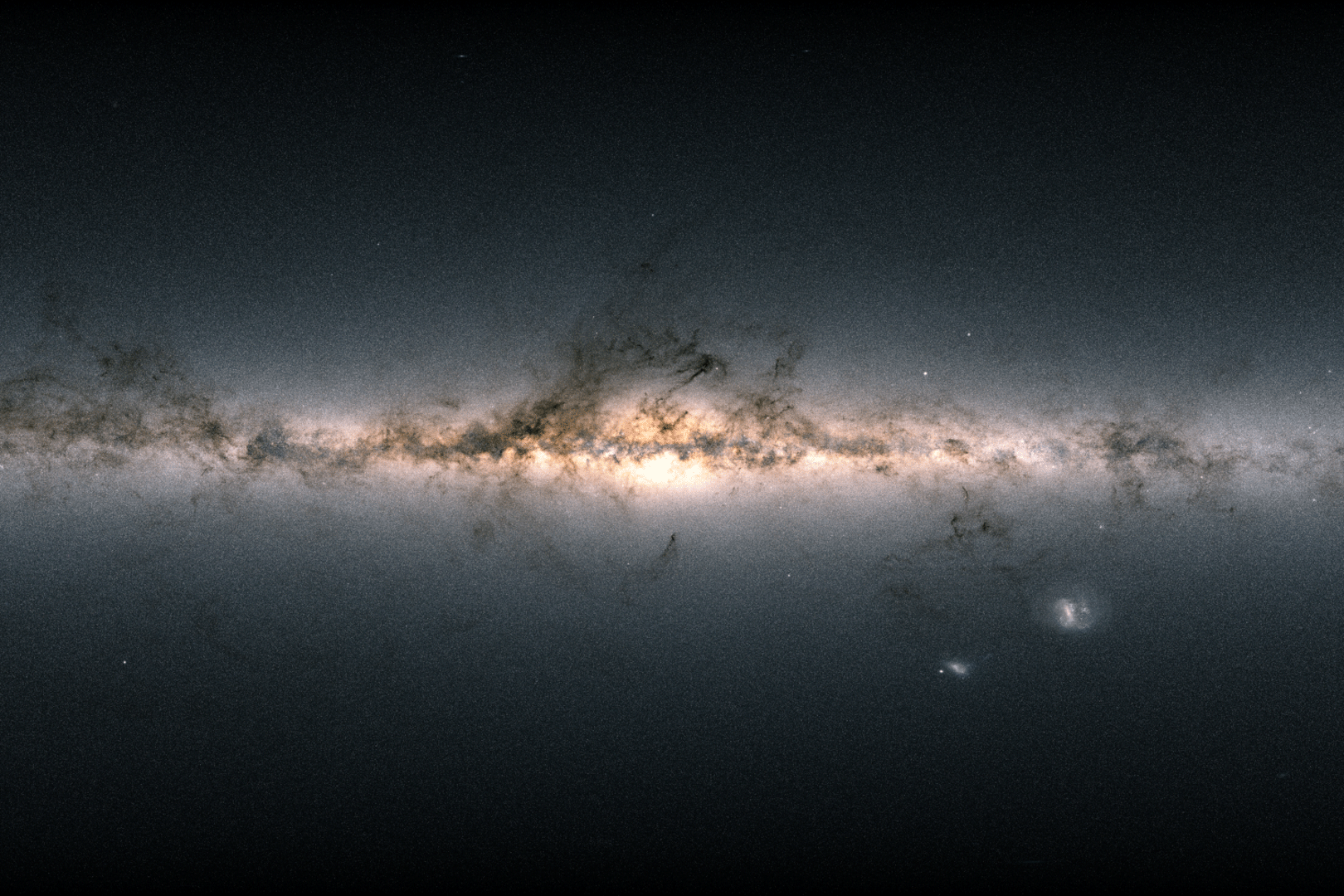NineSigma, representing QRDI / Milaha International LLC (“QRDI / Milaha”), invites participants to submit proposals to design and…
Challenge: Pre-flight AR/VR Content for Autistic Children – Technology Org
Qatar Airways and its technology partner, MADA, are continually enhancing the customer experience for all visitors to improve the…
The next solar storm is on its way – and may cause more problems than you think – Technology Org
We live in such times – we should be prepared for the worst and take adequate precautions. We…
New Wearable Sensor Accurately Tracks Tiny Changes in the Breath Process – Technology Org
Manchester scientists have developed a new type of wearable sensor that can precisely track your breath, even the…
Study: Stars travel more slowly at Milky Way’s edge

By clocking the speed of stars throughout the Milky Way galaxy, MIT physicists have found that stars further out in the galactic disk are traveling more slowly than expected compared to stars that are closer to the galaxy’s center. The findings raise a surprising possibility: The Milky Way’s gravitational core may be lighter in mass, and contain less dark matter, than previously thought.
The new results are based on the team’s analysis of data taken by the Gaia and APOGEE instruments. Gaia is an orbiting space telescope that tracks the precise location, distance, and motion of more than 1 billion stars throughout the Milky Way galaxy, while APOGEE is a ground-based survey. The physicists analyzed Gaia’s measurements of more than 33,000 stars, including some of the farthest stars in the galaxy, and determined each star’s “circular velocity,” or how fast a star is circling in the galactic disk, given the star’s distance from the galaxy’s center.
The scientists plotted each star’s velocity against its distance to generate a rotation curve — a standard graph in astronomy that represents how fast matter rotates at a given distance from the center of a galaxy. The shape of this curve can give scientists an idea of how much visible and dark matter is distributed throughout a galaxy.
“What we were really surprised to see was that this curve remained flat, flat, flat out to a certain distance, and then it started tanking,” says Lina Necib, assistant professor of physics at MIT. “This means the outer stars are rotating a little slower than expected, which is a very surprising result.”
The team translated the new rotation curve into a distribution of dark matter that could explain the outer stars’ slow-down, and found the resulting map produced a lighter galactic core than expected. That is, the center of the Milky Way may be less dense, with less dark matter, than scientists have thought.
“This puts this result in tension with other measurements,” Necib says. “There is something fishy going on somewhere, and it’s really exciting to figure out where that is, to really have a coherent picture of the Milky Way.”
The team reports its results this month in the Monthly Notices of the Royal Society Journal. The study’s MIT co-authors, including Necib, are first author Xiaowei Ou, Anna-Christina Eilers, and Anna Frebel.
“In the nothingness”
Like most galaxies in the universe, the Milky Way spins like water in a whirlpool, and its rotation is driven, in part, by all the matter that swirls within its disk. In the 1970s, astronomer Vera Rubin was the first to observe that galaxies rotate in ways that cannot be driven purely by visible matter. She and her colleagues measured the circular velocity of stars and found that the resulting rotation curves were surprisingly flat. That is, the velocity of stars remained the same throughout a galaxy, rather than dropping off with distance. They concluded that some other type of invisible matter must be acting on distant stars to give them an added push.
Rubin’s work in rotation curves was one of the first strong pieces of evidence for the existence of dark matter — an invisible, unknown entity that is estimated to outweigh all the stars and other visible matter in the universe.
Since then, astronomers have observed similar flat curves in far-off galaxies, further supporting dark matter’s presence. Only recently have astronomers attempted to chart the rotation curve in our own galaxy with stars.
“It turns out it’s harder to measure a rotation curve when you’re sitting inside a galaxy,” Ou notes.
In 2019, Anna-Christina Eilers, assistant professor of physics at MIT, worked to chart the Milky Way’s rotation curve, using an earlier batch of data released by the Gaia satellite. That data release included stars as far out as 25 kiloparsecs, or about 81,000 light years, from the galaxy’s center.
Based on these data, Eilers observed that the Milky Way’s rotation curve appeared to be flat, albeit with mild decline, similar to other far-off galaxies, and by inference, the galaxy likely bore a high density of dark matter at its core. But this view now shifted, as the telescope released a new batch of data, this time including stars as far out as 30 kiloparsecs — almost 100,000 light years from the galaxy’s core.
“At these distances, we’re right at the edge of the galaxy where stars start to peter out,” Frebel says. “No one had explored how matter moves around in this outer galaxy, where we’re really in the nothingness.”
Weird tension
Frebel, Necib, Ou, and Eilers jumped on Gaia’s new data, looking to expand on Eilers’ initial rotation curve. To refine their analysis, the team complemented Gaia’s data with measurements by APOGEE — the Apache Point Observatory Galactic Evolution Experiment, which measures extremely detailed properties of more than 700,000 stars in the Milky Way, such as their brightness, temperature, and elemental composition.
“We feed all this information into an algorithm to try to learn connections that can then give us better estimates of a star’s distance,” Ou explains. “That’s how we can push out to farther distances.”
The team established the precise distances for more than 33,000 stars and used these measurements to generate a three-dimensional map of the stars scattered across the Milky Way out to about 30 kiloparsecs. They then incorporated this map into a model of circular velocity, to simulate how fast any one star must be traveling, given the distribution of all the other stars in the galaxy. They then plotted each star’s velocity and distance on a chart to produce an updated rotation curve of the Milky Way.
“That’s where the weirdness came in,” Necib says.
Instead of seeing a mild decline like previous rotation curves, the team observed that the new curve dipped more strongly than expected at the outer end. This unexpected downturn suggests that while stars may travel just as fast out to a certain distance, they suddenly slow down at the farthest distances. Stars at the outskirts appear to travel more slowly than expected.
When the team translated this rotation curve to the amount of dark matter that must exist throughout the galaxy, they found that the Milky Way’s core may contain less dark matter than previously estimated.
“This result is in tension with other measurements,” Necib says. “Really understanding this result will have deep repercussions. This might lead to more hidden masses just beyond the edge of the galactic disk, or a reconsideration of the state of equilibrium of our galaxy. We seek to find these answers in upcoming work, using high resolution simulations of Milky Way-like galaxies.”
This research was funded, in part, by the National Science Foundation.
The Friday Roundup – Removing the Cringe and YouTube Mistakes
Cringy Editing Habits You Need to Break in 2024 A bit of fun this week from Casey Faris on the subject of just awful editing decisions people make and are sadly, still are making in their editing. The gist of it is they set out to…
Breaking Down the O’Reilly 2024 Tech Trends Report
In the swiftly evolving landscape of technology, keeping pace with the latest trends is vital for anyone in the industry. The O’Reilly 2024 Tech Trends Report emerges as a crucial guide in this endeavor, offering a comprehensive overview of the most significant technological advancements and patterns….
Splatoon 3’s Side Order DLC Hits The Game Next Month

Nintendo revealed during a Direct last September Splatoon 3’s Side Order DLC would be coming to the game sometime in the spring of this year. Now, just a few months later, Nintendo has revealed exactly when: February 22, 2024. That’s when Wave 2 of the Splatoon 3 expansion pass, which features Side Order as the star of the show, goes live, and it’s when players can explore the Spire of Order, a brand new location.
Nintendo announced this news with a short teaser trailer today that shows Agent 8 sleeping on a train. The teaser then transitions to the Spire of Order where a mysterious voice is calling out to Agent 8.
Check it out for yourself below in the Splatoon 3 Side Order DLC release date trailer:
[embedded content]
For the uninitiated, Agent 8 is the protagonist from Splatoon 2’s Octo Expansion. In Side Order, Agent 8 will meet a new character named Acht, who claims to go “way back” with Marina, one of the hosts of Splatoon 2. Marina’s co-host, Pearl, seems to make an appearance of sorts in Side Order as a robot that accompanies Agent 8 on their journey.
With the Spire of Order devoid of color, Acht gives Agent 8 color chips to modify their abilities, like boosting run speed and increasing damage. It’s likely Agent 8’s colored ink will be used to bring color back to the spire, too, but we’ll have to wait until February 22 to find out.
In the meantime, read Game Informer’s Splatoon 3 review, and then check out what else is in the Splatoon 3 expansion pass.
Are you going to check out Side Order next month? Let us know in the comments below!
Tekken 8 Review, Like A Dragon: Infinite Wealth Impressions, Palworld Discourse | GI Show

In this week’s episode of The Game Informer Show, the crew unpacks our Tekken 8 review to discuss what’s great and what’s less great about the latest King of Iron Fist tournament. We also share our early game impressions of Like A Dragon: Infinite Wealth. And lastly, we’ll take a deep dive into Palworld’s meteoric rise and success, as well as the discourse and controversy surrounding it. Of course, it wouldn’t be an episode without answering a few questions from our listeners!
[embedded content]
Follow us on social media: Marcus Stewart (@MarcusStewart7), Kyle Hilliard (@KyleMHilliard), Wesley LeBlanc (@LeBlancWes)
The Game Informer Show is a weekly gaming podcast covering the latest video game news, industry topics, exclusive reveals, and reviews. Join host Alex Van Aken every Thursday to chat about your favorite games – past and present – with Game Informer staff, developers, and special guests from around the industry. Listen on Apple Podcasts, Spotify, or your favorite podcast app.
The Game Informer Show – Podcast Timestamps:
00:00:00 – Intro
00:08:57 – Tekken 8 Review
0046:33 – Like a Dragon: Infinite Wealth
01:07:04 – Palworld
01:39:21 – Housekeeping and Listener Questions










